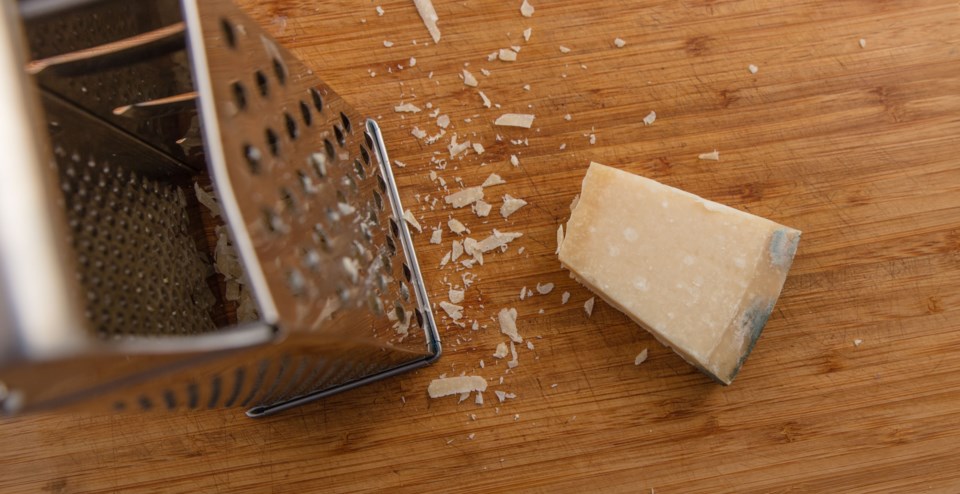Nearly 60 per cent of Canadians chose cheese over comfort classics like bread, pasta, pizza and burgers when asked what food item they couldn't live without, according to a new poll.
The Parmigiano-Reggiano Consortium reports that Canada's imports of the 900-year-old Italian cheese are up 6.8 per cent over the same period in 2021.
"Approximately 14,000 tonnes in the U.S. and maybe 4,000 in Canada. But if you compare this to population, you (Canadians) consume more than double than your American cousins," says Marcello Turini, international marketing coordinator for the consortium.
Turini believes the passion that Canadians have for Parmigiano-Reggiano is due to the country's diversity.
"It's a huge passion that probably was transmitted also from Italian emigrates, so the first Italian community. Also in terms of consumption, I think something changed. The European roots help cheese consumption in general. But nowadays, the Asian community or North African community are absolutely using cheese in their cuisine, and sometimes also experimenting — kind of fusion cuisine," he says.
History of Parmigiano-Reggiano
Parmigiano-Reggiano started with the Benedictine and Cistercian monks around 1000 CE, when they tried to increase the shelf life of a cow's milk supply.
"They started producing this specific cheese, very peculiar cheese; hard and in big wheels, which is produced with a specific grain inside, and casein, which is structurally very, very hard, and can be aged for a long [time]," explains Turini.
In present day, the production of Parmigiano-Reggiano is unchanged since the Middle Ages. In fact, Parmigiano-Reggiano is exclusively produced in five Italian provinces: Parma, Reggio Emilia, Modena, Bologna to the left of the Reno River, and Mantua, to the right of the Po River.
"We still continue to produce (the cheese) without any kind of additives. Only milk, salt and rennet," says Turini. "You have to be very accurate with the milk production in order not to have any kind of bacteria contamination, to avoid problems that you will normally discover after 24 months or two years. So this is a complicated thing."
The consortium is "a kind of police of Parmesan-Reggiano," says Turini. It is a protected body made up of all Parmigiano-Reggiano producers who must abide by specifications that safeguard the unique features of the cheese.
Parmesan or Parmigiano-Reggiano
In 1964, the consortium adopted the dotted inscriptions on the Parmigiano-Reggiano wheels.
"All producers are under consortium control, protected. And obviously, in the same time, promoted," says Turini.
There is, in fact, a difference between Parmesan and Parmigiano-Reggiano. Where the latter is heavily regulated by the consortium to uphold the quality and uniquest of the product, the former is not. This means that unlike the authentic Italian cheese, Parmesan contains preservatives and additives, and includes a longer list of ingredients.
Parmigiano-Reggiano is lactose-free, lower in sodium and healthy compared to its non-authentic counterparts.
"Every lactose-intolerant can eat (the cheese) without any problem," says Turini.
He also adds that there is a lot of confusion around the difference between the two cheeses, especially in the United States.
In Canada, however, Turini says there is more transparency in grocery stores.
"You (Canadians) are lucky because a lot of supermarket chains are clear with this. So they work well, in terms of labelling and exposure of the product and explanation... The rind is also full of dots."
The rules around Parmigiano-Reggiano production by the consortium is meant to protect the Italian product against counterfeits. While fake Parmigiano-Reggiano can pose a threat to the economic success of the cheese, Turini says the cultural impact is also important.
"Consumers are misled in a certain way. They get out from a store having both Parmigiano-Reggiano and Parmesan, and they are absolutely supposed to have the authentic one and in reality, it is not," he says.
"We prefer to be very clear and transparent and say, 'Why don't you call your product American Parmesan?' So the consumer could choose without being misled."



